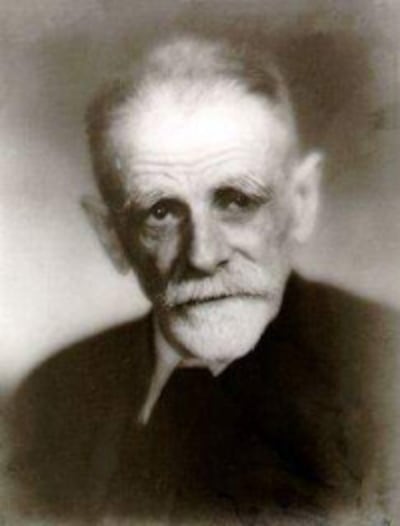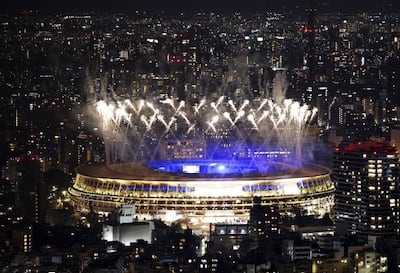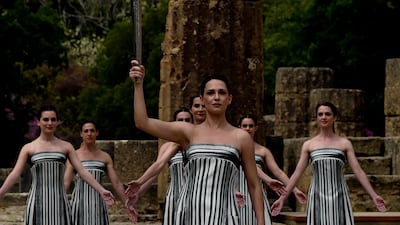The theme tune for this summer's Paris Olympics has been revealed, though it falls flat compared to the Games' official anthem.
Olympic Hymn was played for the first time at the inaugural Olympics in Athens in 1895 and the stirring piece has been heard at every Games since 1960. It is played during the opening and closing ceremonies when the Olympic flag is hoisted and then lowered.
Composed by Victor Le Manse and recorded with the Orchestre National de France, the 2024 theme tune, Parade, is an uplifting symphonic piece that will be heard at venues throughout the international multi-sport event this summer.
But Olympic Hymn is the song that has a longer-lasting connection to the Games. Here is what you need to know about the enduring anthem.
A song for humanity
In the months leading up to the 1895 summer Olympic Games, the International Olympic Committee (IOC) contacted Greek composer Spyridon Samaras to compose the official anthem.
In his mid-thirties at the time, Samaras had already established himself as a rising star of classical music, with lush Italian operas such as the Flora Mirabilis in 1886 and Lionella in 1891 premièring in Milan's Teatro alla Scala.
With further productions set to tour across Europe, Samaras was not exactly jumping through hoops about the prospect of composing the official anthem of the first modern Olympic Games in Athens.
However, national pride gave way and Samaras took the opportunity to soundtrack was one of the largest sporting events in the world, with 14 nations and nearly 200 athletes taking part.
Inaugural IOC president Demetrius Vikelas demanded an epic composition symbolising the universal and dramatic appeal of sportsmanship. He wanted something big and bold – and Samaras obliged with a piece requiring nine philharmonic orchestras and 250 singers to be performed live during the opening ceremony.
The composition follows a framework similar to national anthems or hymns, with the music repeated through different verses.
The ascending melodies, particularly the yearning strings and woodwinds in the verses, are easy on the ear and conjure feelings of empathy and nobility. After a faint and reflective interlude, a robust and brassy chorus arrives to emphasise the celebratory nature of the Olympics.
The concluding coda ties up the main melodic themes while ultimately projecting the humanistic message of the Games.
An ode to valour

Pairing the words to the melodies was Kostis Palamas, the influential poet and essayist renowned for moving Greek literature away from its purists roots to embrace a modern prose.
Drawing upon the values of classical Greek philosophy and the ancient past of the Games, the Olympic Hymn urges competitors to rise to the challenge.
“O Ancient immortal spirit, pure father of beauty, of greatness and of truth. Descend, reveal yourself and flash like lightning here, within the glory of your own earth and sky,” the lyrics read. “At running and at wrestling and at throwing, shine in the momentum of noble contests. And crown with the unfading branch and make the body worthy and ironlike.”
The work ends with a salute to the athletes, stating their heroics are followed and witnessed by all: “plains, mountains and seas glow with you, like a white-and-purple great temple. And hurries at the temple here, your pilgrim. O’ ancient immortal spirit, every nation.”
The resurgence of the Olympic anthem

The performance of the Olympic Hymn appeared to be a one-off event as future host nations like London, Stockholm and Melbourne went on to use their own compositions. Sometimes, as in the case of the 1900 summer Olympics in Paris, there was no anthem at all.
It took more than 60 years for the work of Samaras and Palamas to re-emerge as part of the opening of the 1958 IOC Session, the sporting body's annual general meeting, in Tokyo.
According to the official Olympics website, then IOC member Prince Axel of Denmark was so taken by the work that he officially proposed: “Let us return to this paean rather than what was composed recently, and which the majority of the members do not like.”
With the motion carried unanimously, the Olympic Hymn returned as part of the 1960 winter Games in the US city of Palisades Tahoe, followed by the summer Games in Rome six months later.
The anthem was then played without interruption at all subsequent summer and winter Games. There was a new version at each, with lyrics often sung in the language of the host nation, translated from the song’s original Greek text.
In the ensuing six decades, the Olympic Hymn has been performed in many languages including English, Japanese, French, Russian and Norwegian by opening ceremony performers ranging from Japanese high school students, Chinese children's choirs and Russian soprano Anna Netrebko.
Rescued from the dustbin of history, the Olympic Hymn has gone on to be an anthem for all sporting seasons.


